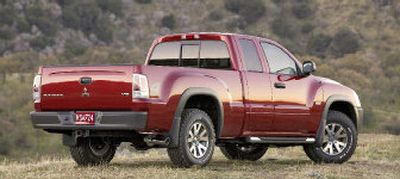Edgy new Raider targets younger set

If you find yourself strangely attracted to Mitsubishi’s new Raider pickup, maybe it’s because you belong to an exclusive group of consumers.
Chances are, says Mitsubishi, you’re a “younger, affluent” buyer with a “strong sense of purpose” and the “confidence needed to get (you) where (you) want to go in life.”
Now, that’s a mean bit of psychographic profiling for a low-volume midsize truck; but it’s also a good indication of the ways manufacturers view markets.
In this case, the premise makes sense. With cars like the Eclipse coupe and the rally based Lancer Evolution, Mitsubishi has staked a claim on the youngish end of the market. The Raider is a logical extension of the strategy. It fills a gap in the Mitsubishi lineup — it’s the company’s first U.S. truck since the Mighty Max disappeared in 1996 — and is without reservation aimed at youngish buyers.
It also may be the final installment in a longstanding relationship with Chrysler, in which cars built by one have been rebadged by the other. The companies apparently will continue to jointly develop engines, but will no longer rebadge each other’s vehicles.
In this case, the Raider is based on Dodge’s Dakota pickup, sharing everything but sheet metal and interior trim. It’s available in two models — extended-cab with a 6-foot-4-inch bed and double-cab with a 5-foot-3-inch bed — and a single, step-side-type body style with flared fenders and aggressively designed front end.
A thin upper grille and thick bumper echo a design theme already established on other Mitsubishi models.
The interior receives a modest amount of bling enhancement, with higher-grade plastics than those found in the Dakota and circular air vents. The Raider retains the Dakota’s firm, comfortable seats, white-faced, chronograph-style gauges and instrument-panel layout. The gauges glow an attractive, faint green when the headlights are on.
The cabin is riddled with handy, rubber-lined storage spaces — enough for sunglasses, cell phones, gloves and etc. — as well as a bin in the center console deep enough and slotted for CDs.
There are three trim levels of the Raider and two engine choices.
The base LS extended-cab Raider ($19,825, including destination) is equipped with such standard gear as air conditioning, tachometer, tinted glass, variable intermittent wipers and rear-wheel ABS. The front seat is a 60/40 split bench.
Up one rung, the midlevel DuroCross ($24,085) trim adds 16-inch alloy wheels, bucket seats, Bluetooth connectivity, remote keyless entry, power windows, seats, mirrors and locks, cruise control and tilt steering.
The uplevel XLS ($25,540) is available only in the double-cab configuration and adds all-wheel-drive, auto-dimming rearview mirror, high-output sound system, leather seats, heated front seats and power folding mirrors.
The available engines are a 3.7-liter V-6 that makes 210 horsepower and 235 foot-pounds of torque and a 230-hp, 4.7-liter V-8 rated at 290 foot-pounds.
Tow rating for the V-6 is 2,950 pounds, while the eight will do 6,200 pounds.
The six is standard and the eight optional on base and DuroCross models, and the V-8 is the only engine offered with the XLS trim.
Eight-cylinder models are available only with a five-speed automatic transmission, while the six can be paired with either a four-speed automatic or close-ratio Getrag six-speed manual.
With the eight, Mitsubishi can boast of being the only import to offer a V-8 choice in a midsize truck. Competitors (read: Toyota and Nissan) reply that their sixes are stronger than Mitsubishi’s eight.
Four-wheel-drive models are fitted with a dash-mounted selector that offers 2-high, 4-lock and 4-low modes. The XLS gets an always-on all-wheel-drive system.
Our extended-cab DuroCross tester was equipped with the four-wheel-drive package that includes all-terrain tires, firmer shocks, tow hooks, skid plates and a limited-slip differential.
It also included an optional high-output Alpine audio system with six-disc in-dash changer and a massive subwoofer enclosure sandwiched between the rear-seat jump seats. On first blush, this seems like a dopey use of space, but it actually makes sense, assuming a booming bass is important to you, because no one sits in that spot anyway.
In the extended-cab version of the Raider, the enclosure is flanked by a pair of jump seats that are too small to be useful for much but your grocery bags and maybe a gym bag.
If you need rear-seat seating space, check out the double-cab version, which starts at $24,325 and offers 36.4 inches of legroom against the extended cab’s 32.1 inches.
A boxed steel frame provides true truck underpinnings, but the coil-over independent front suspension is paired with a solid rear axle to produces a gentler and more planted ride than many trucks have when not laden with cargo. The rack-and-pinion steering system is precise and communicative, and front and rear stabilizer bars effectively control excessive body lean in corners.
Neither engine is so torque-rich that another ratio wouldn’t hurt, but the tranny does a nice job holding the correct gear on an incline. Shifts come quickly and smoothly.
On paper, four-by versions of the Raider should be competent off-roaders, but that rounded front-end makes for a long overhang, which would call for special care around rocks, logs and other detritus of the trail.
Rather, as Mitsubishi explains it, the Raider is an urban vehicle designed to appeal to a youngish population more interested in looking good than in plundering the wilderness. It may be an exclusive group, but it’s a good group and the Raider is on the case.